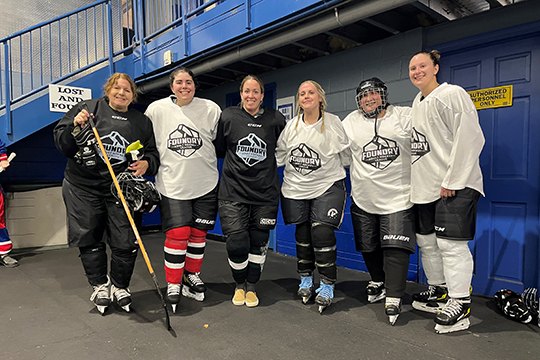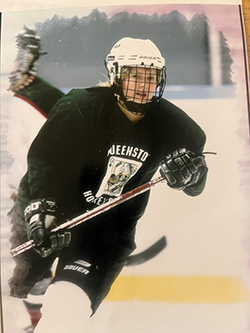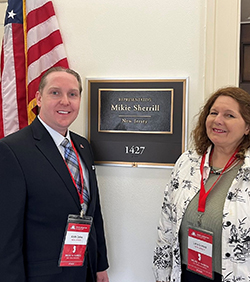“I’m not sure I could have done it without their encouragement and support,” Lara says. “Whenever I would ask if it was okay to do something like play hockey again, they would tell me to go for it.”

For almost thirty years, the ice rink has been a refuge for Lara Gomez. No matter what problems or stress she experienced off the ice, it all disappeared when she went to the rink to skate or play hockey.
Today, it continues to serve as the perfect escape to support her recovery from a life-threatening brain aneurysm that she suffered 10 years ago. Now a decade after that near tragedy, Lara is doing what she loves again – playing hockey, skating, sailing and creating art.
 Lara had just been through an extremely stressful time, caring for her terminally ill mother who eventually succumbed to cancer. While trying to distract herself from the grief she felt, Lara decided to take her six-year-old daughter to go ice skating at a local rink when she fell ill.
Lara had just been through an extremely stressful time, caring for her terminally ill mother who eventually succumbed to cancer. While trying to distract herself from the grief she felt, Lara decided to take her six-year-old daughter to go ice skating at a local rink when she fell ill.
“I had a headache that day, and just didn’t feel right,” Lara remembers. “I thought that skating and getting some exercise may help. As I bent over to tie my skates, I felt a pain that was like a gunshot to the back of my head. I threw up, couldn’t speak and fell to the floor.”
Lara has trouble remembering specifics about the day, but she does recall pointing to her brother’s phone number on her cell phone to get help. Her brother is a nurse at Riverview Medical Center in Red Bank. Her daughter was able to reach Lara’s brother and somehow, Lara drove to the Emergency Department.
After having an MRI and consulting with the attending neurologist there, physicians determined that she suffered a ruptured aneurysm and would need emergency surgery at a center equipped with the necessary technology and experience to treat severe cases like Lara’s. She was transferred immediately to RWJUH.
RWJUH’s Brain Aneurysm Program is highly experienced in performing both open cerebral (clipping treatment or craniotomy) and endovascular/neurointerventional procedures (coils, pipeline flow diversion device, liquid embolics, stents) to treat brain aneurysms. The multidisciplinary team features neurosurgeons, neurointerventional radiologists, neurologists who also specialize in the care of stroke patients, a neuropsychologist and nurses experienced in neurocritical care.
After she arrived at RWJUH, Gaurav Gupta, MD, Associate Professor of Neurosurgery, Director, Cerebrovascular and Endovascular Neurosurgery at RWJUH and Rutgers Robert Wood Johnson Medical School (RWJMS); and Sudipta Roychowdhury, MD, Director of Interventional Neuroradiology at RWJUH and Clinical Assistant Professor of Radiology at RWJMS; performed an emergency procedure that involved inserting two clips to close off the aneurysm in Lara’s brain. Both Dr. Gupta and Dr. Roychowdhury are highly experienced in treating brain aneurysms.
During a clipping procedure, doctors make an opening in the patient’s skull to reach the brain. They use an operating microscope and small instruments to avoid damaging nerves, blood vessels and brain tissue. Once the blood vessel and aneurysm are isolated from surrounding brain tissue, surgeons place a metal clip across the aneurysm’s neck to cut off blood flow from the artery that is feeding the aneurysm.
 “For complex brain surgeries, we have all the expertise within RWJUH and Rutgers RWJMS’ Neurosurgery and Neuroscience programs,” Dr. Gupta notes. “We are one of the most advanced programs in the country for treatment of brain aneurysms.”
“For complex brain surgeries, we have all the expertise within RWJUH and Rutgers RWJMS’ Neurosurgery and Neuroscience programs,” Dr. Gupta notes. “We are one of the most advanced programs in the country for treatment of brain aneurysms.”
After nearly two weeks inRWJUH’s Neurocritical ICU, Lara was transferred to an inpatient rehabilitation facility specializing in helping patients recover from brain injuries and trauma. She needed to wear a helmet to protect the exposed part of her brain while completing her rehabilitation both at the facility and at home. It took nearly eight months for her to recover and she still struggled with her speech at times, “mixing-up” some words that she wanted to say.
Lara had little or no warning signs leading up to her ruptured aneurysm, but she later learned that a relative may have suffered one.
According to Dr. Roychowdhury, similar to Lara’s case, most patients don’t know they have a brain aneurysm until it leaks or bleeds. Brain aneurysms can also run in families.
“My grandfather’s brother had one and lived after surgery,” Lara recalls. “At the time, everyone said he had a heart attack, but I learned years later after he passed away that he had an aneurysm.”
Lara credits Dr. Gupta’s and Dr Roychowdhury’s positive attitude and support with helping her return to the activities and hobbies that she enjoys.
“I’m not sure I could have done it without their encouragement and support,” Lara says. “Whenever I would ask if it was okay to do something like play hockey again, they would tell me to go for it.”
And go for it she did. Just this past year, Lara and her hockey team the Green Goombas, which play in a Jersey Shore Arena Foundry League, won a championship. She is currently competing with the newly formed Garden State Grizzlies hockey team in an all-women’s league.
In addition to hockey. Lara sails and paints original pieces which she plans to organize and feature in a future exhibit. Another important part of her recovery has been her advocacy efforts to raise awareness about brain aneurysms. She has traveled to Washington, D.C. to share her experience at Advocacy Day and rally support for Ellie’s Law.
“Ellie’s Law” (H.R. 902/S. 895) designates $50 million over five years for critical research, with the goal of medical advances to prevent potentially fatal brain aneurysms from rupturing and improve the quality of life for survivors.
“It’s important that we support more funding for Ellie’s Law to make sure people who suffer brain aneurysms receive the proper care they need immediately or to prevent them from happening,” Lara notes.
Learn more about Robert Wood Johnson University Hospital Brain Aneurysm Program.